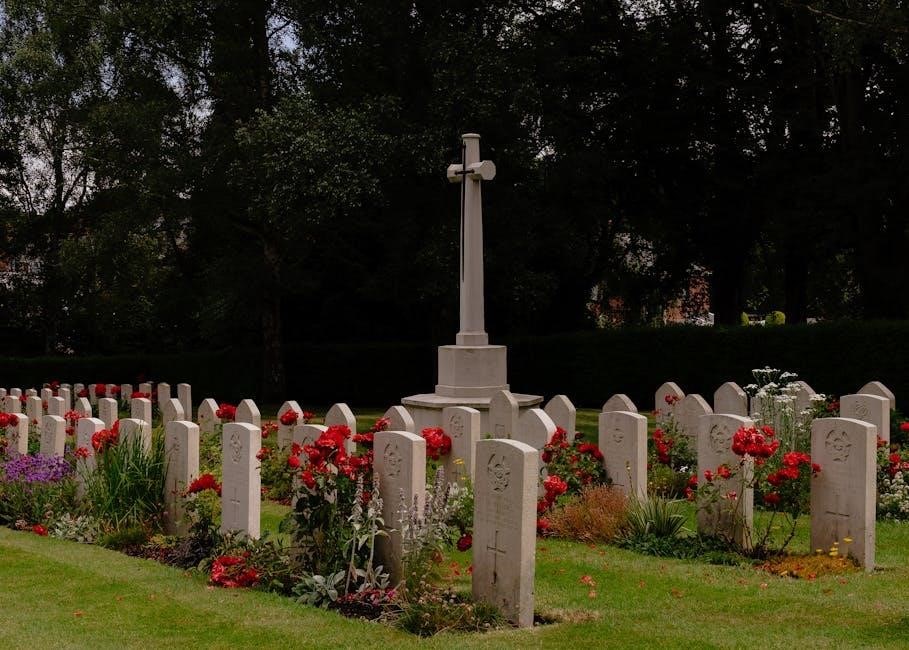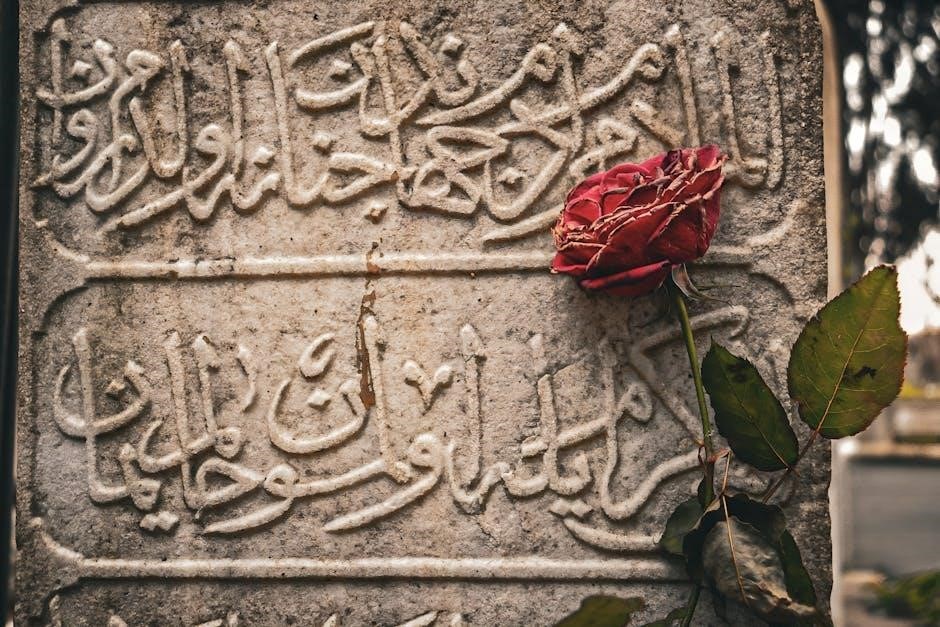Cemetery symbols are more than just decorations; they offer insights into the lives, beliefs, and cultural backgrounds of the deceased, serving as a silent bridge to the past.
1.1 The Importance of Understanding Cemetery Symbols
Understanding cemetery symbols is crucial for decoding the hidden stories and emotions behind gravestones. These symbols reveal insights into the deceased’s life, beliefs, and cultural background, serving as silent storytellers. They also act as tools for genealogical research, helping trace family histories and uncover historical contexts. Grasping their meanings bridges the past and present, offering a deeper connection to our heritage.
1.2 Brief History of Cemetery Symbolism
Cemetery symbolism traces its roots to ancient cultures, where symbols like skulls and hourglasses represented mortality and the passage of time. Early Christians used crosses and angels to signify faith and resurrection. The Victorian era popularized intricate designs, blending religious and secular motifs. Over time, symbols evolved, reflecting cultural and religious shifts, becoming a universal language to honor the deceased and their legacies.

Common Cemetery Symbols and Their Meanings
Cemetery symbols like angels, skulls, and hourglasses convey profound meanings, reflecting beliefs about life, death, and the afterlife, while offering insights into the deceased’s identity and legacy.
2.1 Angels and Their Roles in Cemetery Symbolism
Angels are common cemetery symbols, representing guardianship and protection of the soul. They often signify spirituality and serve as messengers of hope. Weeping angels denote sorrow, while trumpeting angels herald resurrection. Their presence on gravestones offers comfort to mourners, symbolizing divine guidance and eternal peace for the departed.
2.2 Skulls and Their Representation of Mortality
Skulls in cemeteries symbolize mortality and the inevitability of death. They often represent the transience of life and humanity’s shared fate. Winged skulls may signify the soul’s ascent to the afterlife, while unadorned skulls underscore the natural cycle of life and death, serving as poignant reminders of life’s brevity and universal destiny.
2.3 The Flying Hourglass and the Passage of Time
The flying hourglass embodies the swift passage of time, its wings symbolizing the soul’s journey to eternity. It reminds us that life is fleeting, urging the living to cherish each moment. This emblem, often found on Victorian-era graves, reflects a deep contemplation of mortality and the afterlife, blending time’s inevitability with spiritual transcendence.
2.4 The Anchor as a Symbol of Hope
The anchor, a steadfast symbol of hope, signifies stability and faith in eternity. Often linked to maritime professions, it also represents spiritual anchorage, guiding the deceased through life’s storms to eternal peace. Its presence on headstones offers solace to mourners, embodying resilience and the promise of a calm afterlife.
2.5 The Fleur-de-Lis and Its Historical Significance
The Fleur-de-Lis, a stylized lily symbol, carries deep historical and religious meaning. Originating in French heraldry, it represents purity, nobility, and divine righteousness. Often used in coats of arms and religious art, it signifies a connection to French heritage or spiritual devotion. In cemeteries, it honors the deceased’s faith or lineage, embodying timeless elegance and sacred traditions.
Religious and Secular Symbols in Cemeteries
Religious symbols like crosses and angels reflect spiritual beliefs, while secular symbols such as hearts and nature imagery represent love and personal traits, blending faith and emotion in memorials.
3;1 Christian Symbols: Crosses, Angels, and Scriptures
Christian symbols in cemeteries often include crosses, representing resurrection, and angels, signifying guardianship and spirituality. Scriptures or biblical quotes are frequently inscribed, expressing faith and comforting mourners. These symbols honor the deceased while offering solace to the living, reflecting deep-rooted religious beliefs and hope for eternal life.
3.2 Secular Symbols: Hearts, Hands, and Nature Imagery
Secular symbols like hearts, often representing love, and hands, signifying unity or farewell, are common in cemeteries. Nature imagery, such as trees or flowers, may symbolize life’s cycle or eternal memory. These symbols transcend religious ties, offering universal messages of affection, connection, and the enduring impact of a life well-lived.
Military and Occupational Symbols
Military and occupational symbols honor the deceased’s professions and service. Flags, rifles, and badges denote military roles, while tools, anchors, and gargoyles reflect trades and legacies.
4.1 Military Symbols: Flags, Rifles, and Badges
Military symbols, such as flags, rifles, and badges, honor the deceased’s service and sacrifice. Flags represent nationality or allegiance, while rifles signify a soldier’s role. Badges often denote rank, unit, or achievements, commemorating their dedication and contributions. These symbols provide a visual tribute to their military legacy, offering insights into their lives and service.
4.2 Occupational Symbols: Tools, Anchors, and Gargoyles
Occupational symbols like tools, anchors, and gargoyles reflect the deceased’s profession or life’s work. Tools signify craftsmanship or trade, while anchors often represent maritime careers. Gargoyles, inspired by Gothic architecture, may honor stonemasons or architects. These symbols serve as enduring tributes to the individual’s contributions, offering a glimpse into their earthly pursuits and legacies.

Cultural Variations in Cemetery Symbols
Cultural variations in cemetery symbols reflect diverse beliefs, traditions, and values. Jewish symbols, Celtic knots, and Victorian motifs highlight unique heritage, offering insights into the deceased’s origins and faith.
5.1 Jewish Cemetery Symbols and Their Meanings
Jewish cemetery symbols often include the Star of David, menorahs, and Hebrew inscriptions, reflecting faith and heritage. These symbols honor the deceased’s life, beliefs, and contributions, serving as a bridge to their cultural and religious legacy.
5.2 Celtic and Victorian Cemetery Symbolism
Celtic crosses and intricate knotwork symbolize eternal life and spiritual connection. Victorian symbols, like roses and angels, reflect love, mourning, and afterlife beliefs. These designs often blend nature and religion, offering deeper insights into the cultural and emotional context of the deceased during these periods.
Symbols as Guides to Genealogical Research
Cemetery symbols often reveal family histories, occupations, and beliefs, aiding genealogists in uncovering lineage and connecting generations through visual storytelling.
6.1 How Symbols Can Reveal Family Histories
Cemetery symbols often provide clues about a person’s life, such as occupation, beliefs, or heritage. For example, an anchor may indicate maritime work, while a book could signify religious devotion. These visuals guide genealogists to explore specific records or cultural practices, enriching family histories and connecting generations through meaningful imagery.
6.2 Using Symbols to Break Down Genealogical Brick Walls
Cemetery symbols act as silent puzzles, offering clues about a person’s occupation, faith, or heritage. A winged hourglass may signify the passage of time, while an anchor could indicate a maritime career. These images guide researchers to specific records or cultural practices, aiding in overcoming genealogical challenges and connecting generations through meaningful imagery.

The Language of Symbols in Cemeteries
Cemetery symbols form a visual language, conveying messages about life, death, and eternity. They encode emotions, beliefs, and stories, offering a profound way to understand the past.
7.1 Deciphering the Hidden Meanings of Cemetery Art
Cemetery art reveals deeper truths through symbols like wings, hourglasses, and anchors, each carrying specific meanings. These visual cues guide interpretations of the deceased’s life, beliefs, and legacy, offering insights into their journey and values. By decoding these images, visitors can uncover stories that transcend written words, connecting with the past in a profound way.
7.2 The Role of Icons in Telling Life Stories
Icons on gravestones serve as silent narrators, revealing personal traits, achievements, and beliefs. Symbols like angels, anchors, and hourglasses convey emotions and aspirations, while occupational emblems highlight the deceased’s profession. These visual storytellers create a lasting connection, bridging generations and preserving memories, offering comfort and insight into the lives they commemorate.
Cemeteries as Sculpture Gardens
Cemeteries often double as sculpture gardens, showcasing intricate artistry and craftsmanship; Elaborate statues and monuments transform burial grounds into spaces of aesthetic and historical significance, attracting visitors worldwide.
8.1 The Artistry Behind Cemetery Monuments
Cemetery monuments showcase exceptional craftsmanship, transforming grave markers into works of art. Sculptors often incorporate symbolic imagery, such as angels, flora, and intricate details, to convey emotional and cultural narratives. These designs not only honor the deceased but also reflect the era’s artistic styles and societal values, preserving history through stone.
8.2 The Attraction of Cemeteries as Tourist Destinations
Cemeteries attract tourists worldwide for their historical significance, artistic monuments, and serene ambiance. Visitors drawn to sites like Père-Lachaise or Cave Hill Cemetery marvel at intricate sculptures, symbolic grave markers, and the stories they tell. These destinations offer a unique blend of education, reflection, and aesthetic beauty, making them popular cultural and historical attractions.

The Evolution of Cemetery Symbols
Cemetery symbols have evolved over centuries, reflecting changing beliefs, cultural influences, and artistic trends, blending traditional motifs with modern interpretations to honor the deceased meaningfully.
9.1 Historical Development of Cemetery Symbolism
Cemetery symbolism has journeyed from simple grave markings to intricate designs, reflecting shifting cultural and religious values. Early symbols often represented mortality, while Victorian-era designs embraced elaborate motifs like angels and hourglasses, signifying hope and the afterlife. This evolution mirrors societal changes, blending tradition with modern interpretations to honor the deceased meaningfuly.
9.2 Modern Tributes and Their Symbolic Meanings
Modern cemetery symbols blend tradition with personalization, offering unique ways to honor loved ones. Teddy bears symbolize comfort and protection, often for children, while sheaves of wheat represent a life well-lived. Personalized engravings, such as hobbies or interests, add a contemporary touch, celebrating individuality and creating lasting memories that resonate with families and future generations.

Tools for Understanding Cemetery Symbols
Guidebooks, field guides, and apps like Cave Hill Cemetery’s offer insights into symbols, aiding genealogists and history enthusiasts in deciphering meanings and uncovering hidden stories.
10.1 Guidebooks and Field Guides
Guidebooks and field guides provide detailed explanations of cemetery symbols, helping researchers decode their meanings. These resources often include illustrations and historical context, making them invaluable for genealogists and history enthusiasts. Tui Snider’s Understanding Cemetery Symbols is a popular example, offering insights into the origins and significance of various gravestone imagery. They serve as essential tools for exploring historic graveyards.
10.2 Apps and Digital Resources for Cemetery Symbolism
Digital tools like the Cave Hill Cemetery app offer interactive guides to decipher cemetery symbols, providing historical context and navigational aids. These resources enable users to explore gravestone art, understand meanings, and uncover hidden stories. Apps like these enhance cemetery tours and genealogical research, making symbolism accessible to a broader audience with just a few taps.

The Role of Cemeteries in Preserving History
Cemeteries serve as archives of cultural and historical information, with symbols, epitaphs, and memorials reflecting societal values, traditions, and the lives of the deceased, preserving history.
11.1 Cemeteries as Archives of Cultural and Historical Information
Cemeteries are more than resting places; they are archives of cultural and historical information. Symbols, inscriptions, and artwork on gravestones reveal societal values, religious beliefs, and historical events. For example, the flying hourglass symbolizes the passage of time, while anchors represent hope, reflecting the cultural and maritime heritage of the deceased. These elements preserve history, offering insights into past lives and traditions.
11.2 The Importance of Preserving Cemetery Symbols
Preserving cemetery symbols is vital for maintaining cultural and historical heritage. These symbols serve as visual records of societal values, religious beliefs, and personal stories; Losing them would erase a layer of history, making it harder for future generations to understand past cultures and traditions. Preservation ensures these silent storytellers continue to educate and inspire, honoring the lives they represent.
Cemetery symbols are a language of stories, beliefs, and history, offering insights into lives past. Their preservation ensures future generations can decipher their meanings and legacy;
12.1 The Enduring Legacy of Cemetery Symbols
Cemetery symbols leave a lasting legacy, preserving history and emotions. They serve as silent storytellers, connecting the past with the present, and ensuring memories endure for generations to explore and cherish.
12.2 Final Thoughts on the Significance of Cemetery Symbolism
Cemetery symbols are a bridge to the past, offering insights into lives, beliefs, and cultural heritage. They transcend time, connecting the departed with the living, and serve as a visual language that enriches our understanding of history, faith, and identity. Their enduring presence ensures that stories and legacies are never forgotten.
